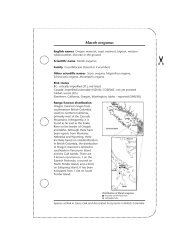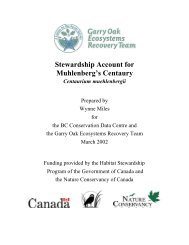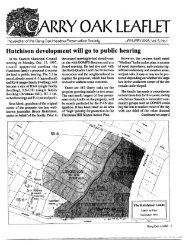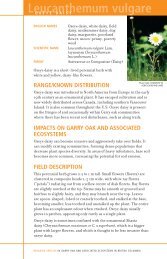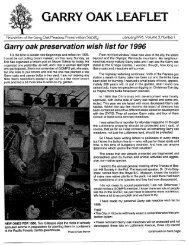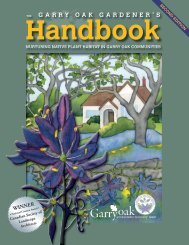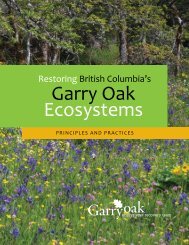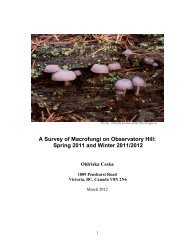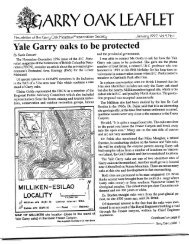PDF 320KB - Garry Oak Ecosystems Recovery Team
PDF 320KB - Garry Oak Ecosystems Recovery Team
PDF 320KB - Garry Oak Ecosystems Recovery Team
You also want an ePaper? Increase the reach of your titles
YUMPU automatically turns print PDFs into web optimized ePapers that Google loves.
PRESCRIBED FIRE AT THE COWICHAN GARRY<br />
OAK PRESERVE - SEPT 15, 2010<br />
Irvin Banman<br />
The Nature Conservancy of Canada<br />
The deep-soil <strong>Garry</strong> oak meadows on southeast Vancouver Island<br />
were historically managed by First Nations for camas harvest, as<br />
foraging areas for elk and deer which were hunted, and also for the<br />
procurement of a variety of other plants for food and medicines.<br />
The main management tool used to maintain the open meadow or<br />
savannah structure was fire, which was used on a cyclical basis in<br />
order to control grasses, shrubs and conifer encroachment while<br />
promoting the growth of camas, which was a major food source.<br />
Since the cessation of routine burning more than 150 years ago when<br />
the first European settlers arrived, the remaining meadow fragments<br />
that have not disappeared due to urban expansion or agriculture have<br />
been invaded by agronomic grasses, native and non-native shrub and<br />
tree species and a host of other introduced plants.<br />
At the 52-acre Cowichan <strong>Garry</strong> <strong>Oak</strong> Preserve, the Nature Conservancy<br />
of Canada (NCC) is once again using fire to control introduced<br />
species, mainly grasses for the time being. Based in part on research<br />
carried out by Dr. Andrew MacDougall in the past 10 years, and a 5-<br />
year study carried out in partnership with the Institute of Applied<br />
Ecology out of Corvallis Oregon, prescribed fire is being reintroduced.<br />
It has taken 10 years to establish a rapport with local authorities<br />
whose cooperation and permission to burn is essential. The<br />
Municipality of North Cowichan, the Ministry of Forests, and the<br />
local fire hall approved our burn plan and special permission to burn<br />
was granted to burn in early fall. Three units were burned September<br />
15, 2010, the intent being to control grasses and to observe the overall<br />
effects of fire. Of the three burn units, one was a study plot set up by<br />
Kate Proctor from the University of Victoria to determine, among<br />
other things, the response of the native and non-native plant<br />
community and of camas in particular.<br />
<strong>Garry</strong> <strong>Oak</strong> <strong>Ecosystems</strong> <strong>Recovery</strong> <strong>Team</strong> – Research Colloquium 2010 Page 22




